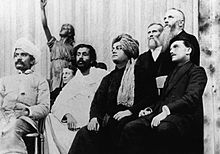
Rashtriya Swayamsevak Sangh is an Indian right-wing, Hindu nationalist volunteer paramilitary organisation. It is the progenitor and leader of a large body of organisations called the Sangh Parivar, which has developed a presence in all facets of Indian society and includes the Bharatiya Janata Party, the ruling political party under Narendra Modi, the 14th prime minister of India. Mohan Bhagwat has served as the Sarsanghchalak of the RSS since March 2009.
The following outline is provided as an overview of and topical guide to Hinduism:

A Jain temple, Derasar or Basadi is the place of worship for Jains, the followers of Jainism. Jain architecture is essentially restricted to temples and monasteries, and Jain buildings generally reflect the prevailing style of the place and time they were built.
Jainism is an ancient Indian religion belonging to the śramaṇa tradition. It prescribes ahimsa (non-violence) towards all living beings to the greatest possible extent. The three main teachings of Jainism are ahimsa, anekantavada (non-absolutism), aparigraha (non-possessiveness). Followers of Jainism take five main vows: ahimsa, satya, asteya, brahmacharya (chastity), and aparigraha. Monks follow them completely whereas śrāvakas (householders) observe them partially. Self-discipline and asceticism are thus major focuses of Jainism.

The credit for introducing Jainism to the West goes to a German scholar, Hermann Jacobi, who translated some Jain literature and published it in the series 'Sacred Books of East' in 1884. In Europe, the largest Jain populations are in Britain, with a population of about 25,000.
Ramjee Singh is a former Member of Parliament and vice-chancellor of Jain Vishva Bharati University. He is an eminent Gandhian and is the author of a number of books on him. He was also the director of Gandhian Institute of Studies, Varanasi, India. In January 2020 he was awarded the fourth highest civilian award in the country: The Padma Shri for Social Work. His life has been a blend of being a Gandhian academician as well as an activist. Singh has declared Mahatma Gandhi as the Bodhisattva of the 20th century.

Sushil Kumar was a Jain teacher and monk. He was a self-realized master who devoted more than 50 years to promoting non-violence, peace and knowledge of the self.

JAINA is an acronym for the Federation of Jain Associations in North America, an umbrella organizations to preserve, practice, and promote Jainism in USA and Canada. It was founded in 1981 and formalized in 1983. Among Jain organization it is unique in that it represents Jains of all sects, and thus effectively represents the entire Jain community in USA and Canada.

Jainism is an Indian religion which is traditionally believed to be propagated by twenty-four spiritual teachers known as tirthankara. Broadly, Jainism is divided into two major schools of thought, Digambara and Śvetāmbara. These are further divided into different sub-sects and traditions. While there are differences in practices, the core philosophy and main principles of each sect is the same.

The Brahma Jinalaya, sometimes called as the Greater Jain Temple of Lakkundi, is an early 11th-century Mahavira temple in Lakkundi, Gadag District of Karnataka state, India. The temple is attributed to Attiyabbe, the wife of the local governor Dandanayaka Nagadeva. It faces east, has a mukhamandapa, a gudhamandapa and its sanctum is covered by a sur-temple style vimana superstructure. The temple is notable for its reliefs depicting Jaina artwork, statues of the Tirthankaras and the two statues of Brahma and Saraswati inside its inner mandapa.
Sompura Salat are a Hindu stone-worker community of Gujarat, They are also found in southern Rajasthan, specially in the Mewar region. Their origin is said to be from Prabhas Patan famous for the Somnath temple. The term "salat" is derived from Shilavat, the old term for a temple architect.
The history of Jainism in Australia is relatively short when compared to the history of Christianity on the same continent. There are four Jain centres in Australia. The Jain population in Australia was counted in the 2016 census to be 4,047, of whom 38% lived in Greater Sydney, 31% in Greater Melbourne, and 15% in Greater Perth. The states and territories with the highest proportion of Jains are Western Australia (0.025%) and Victoria (0.022%), whereas those with the lowest are Queensland (0.006%) and Tasmania (0.001%). As per the latest census (2021), the Jain population in Australia is 5,851, which is a 44.5% increase between 2016-2021.

Adherents of Jainism first arrived in the United Kingdom in the 19th century. Britain, mainly England, has since become a center of the Jain diaspora with a population of 40,000 in 2007. The 2021 United Kingdom census recorded a population of 24,991 Jains in England and Wales, and 44 Jains in Northern Ireland.
There are references in Jain texts to various areas of Southeast Asia. During the reign of Samprati, Jain teachers were sent to various Southeast Asian countries.
Jainism and Hinduism are two ancient Indian religions. There are some similarities and differences between the two religions. Temples, gods, rituals, fasts and other religious components of Jainism are different from those of Hinduism.
Panchasara Parshwanath Temple is a Śvetāmbara Jain temple located in Patan, Gujarat. The temple was constructed in 8th century during the reign of Vanaraja Chavda of Chavda dynasty.
























